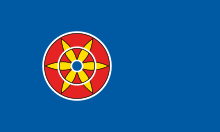Kvens
| kveeni | |
|---|---|

Unofficial flag
|
|
| Total population | |
| 10,000–60,000 | |
| Regions with significant populations | |
|
|
|
| Languages | |
| Kven/Finnish,[1]Norwegian | |
| Religion | |
| Lutheranism, including Laestadianism | |
| Related ethnic groups | |
| Finns and Tornedalians |
Kvens (Kven/Finnish: kveeni, Norwegian: kvener, Northern Sami: kveanat) are a Finnic ethnic minority in Norway who are descended from Finnish peasants and fishermen who emigrated from the northern parts of Finland and Sweden to Northern Norway in the 18th and 19th centuries. In 1996, the Kvens were granted minority status in Norway, and in 2005 the Kven language was recognized as a minority language in Norway.
The origin of the term Kven is disputed. There is no evidence that modern Kvens are descendants of the Kvens mentioned in a few ancient Norwegian and Icelandic sources. As a result of Norway signing the Framework Convention for the Protection of National Minorities in 1999, the term Kven became for the first time an official name, the name of Finnish descendants with a long history in Norway who view themselves as a member of that particular ethnic minority group of Finnish descent.
There is a theory among some academic groups that due to the discrimination and suppression by the Norwegian authorities the term Kven became derogatory in the late 19th century. Therefore, many Kvens preferred to be called 'suomalaiset' (finns). But with the revitalization of the Kven culture in the 1970s, Kvens themselves started using the term. However, even in the 1990s there was a debate whether the Norwegian terms 'finne', 'finsk', or 'finskætted' (respectively a Finnish person, Finnish, and of Finnish origin) should be used instead. However, today the term Kven is accepted and used, for example, in the name of the Kven organization in Norway (Norske Kveners Forbund).
The Kvens were registered as a separate group in the Norwegian censuses in the period 1845 to 1930. From the 18th century the Kvens started to comprise a significant part of the population in Northern Norway. In 1845 13.3% of the population in Finnmark, and 3.2% in Troms, considered themselves as Kvens. In 1854 the numbers increased to respectively, 19.9% and 7.0%. The peak was in 1875, with respectively 24.2% and 7.7%. The ratios were reduced to respectively 20.2% and 3.7%, in 1890, and 13.8% and 2.0% in 1900 (all numbers from). In the 1930 census there were 8,215 registered Kvens in Troms and Finnmark. In 1950, 1,439 people reported that they used the Finnish language in Troms (58 people) and Finnmark (1,381 people).
...
Wikipedia
